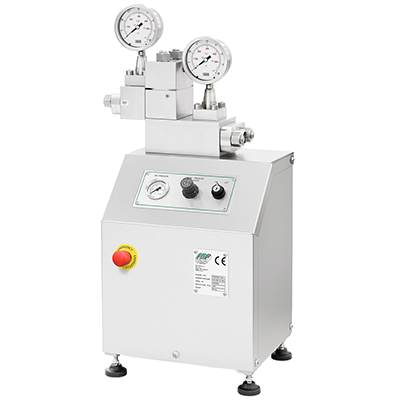A valve, multiple purposes
The Remote Homogenizing Valve (RHV) consists of a complete homogenizing chamber that can be operated independently from what’s already in place (only requiring compressed air supply) and is applicable on the following machinery for different objectives:
- 1. Homogenizer: if it has a single stage, it can be converted into a two-stage homogenizer (when feasible, even remotely, post the aseptic phase) RHV equipped with a singular pressure gauge..>
- 2. Piston pump: if one aims to use it for homogenizing> , RHV with one pressure gauge.
- 3. Piston pump: if the goal is to keep its pumping functionality (system feed) and subject the product to the homogenizing step, > RHV with two pressure gauges.

RHV featuring a single pressure gauge, for reading the homogenization pressure.

RHV with a dual pressure gauge: on the right for monitoring the total operational pressure; on the left for reading the system’s counterpressure. The value of the homogenizing pressure is determined by the difference between these two readings.
How is our Remote Homogenizing Valve constructed?
- The homogenizing chamber: : is crafted from stainless steel and, along with all its components, is machined with ultra-precise tools to ensure the perfect alignment of the Homogenizing Valve components (made up of the Passage Head, Impact Head, and Impact Ring) and to achieve optimal processing of the treated product.
- Pressure gauge (either single or double) of an analog type, complete with a sanitary membrane separator.
- The oleo-pneumatic assembly, housed within the structure, is responsible for regulating the homogenizing pressure. This setup involves directing oil to the Impact Head, thwarting the onset of vibrations in the Homogenizing Valve.
- Structure is made of stainless steel.
Implementing the Remote Homogenizing Valve is an uncomplicated procedure on FBF Italia machines, given our understanding of their technical dimensions. As a result, we can offer all the necessary adjustments for this application’s integration and its functional specifications. For machinery made by other manufacturers, an individual feasibility evaluation will be necessary.
